Developing Individuals, Teams and Organisation
VerifiedAdded on 2020/12/09
|15
|4871
|373
Report
AI Summary
This report examines the importance of developing individuals and teams within organizations, using Kingfisher plc as a case study. It analyzes the knowledge, skills, and behaviors required by HR professionals, the differences between individual and organizational learning, and the need for continuous learning and professional development to drive sustainable business performance. The report also delves into high-performance working and its impact on employee engagement and competitive advantages, and explores different approaches to performance management that support a high-performance culture and commitment.
Contribute Materials
Your contribution can guide someone’s learning journey. Share your
documents today.
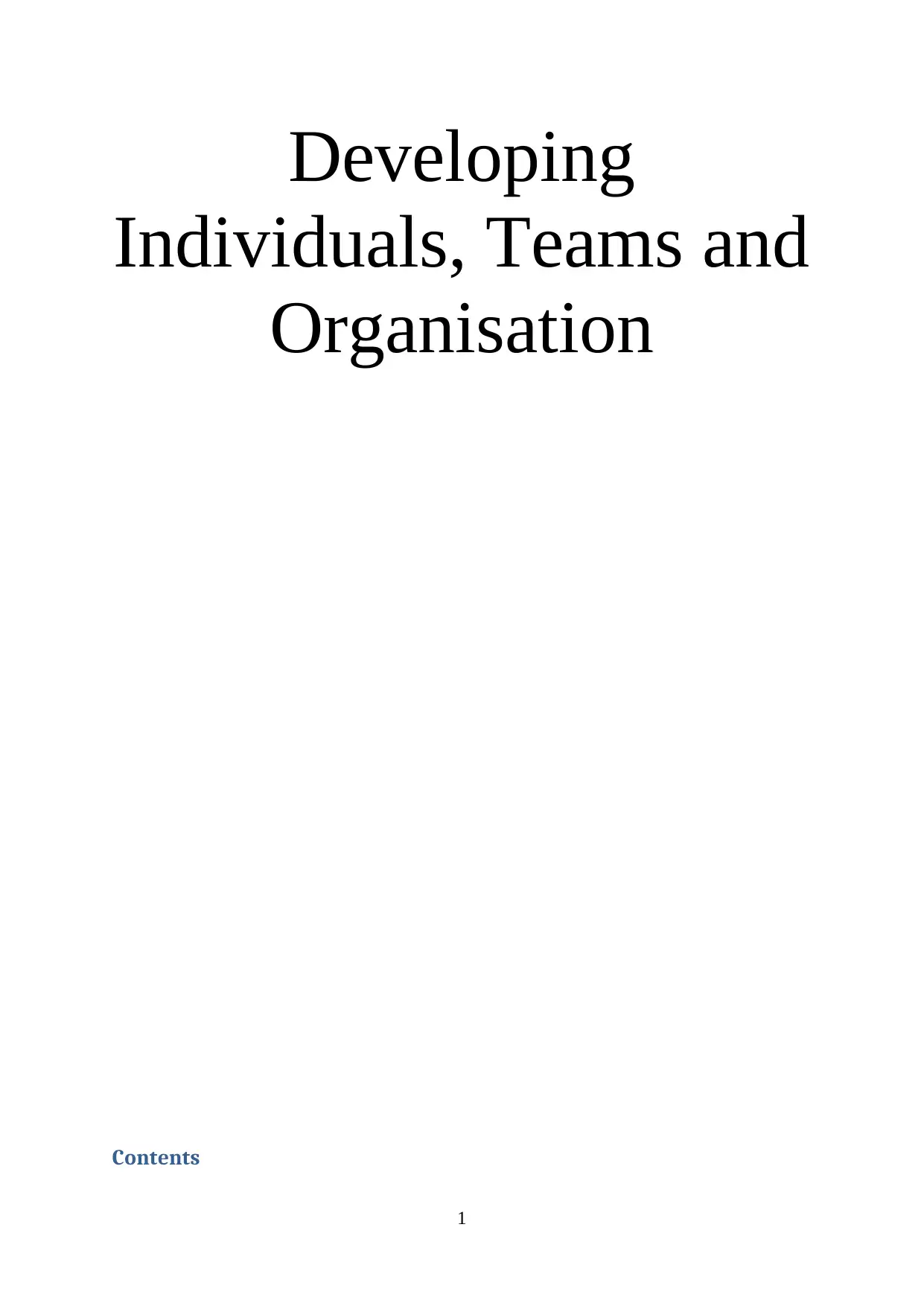
Developing
Individuals, Teams and
Organisation
Contents
1
Individuals, Teams and
Organisation
Contents
1
Secure Best Marks with AI Grader
Need help grading? Try our AI Grader for instant feedback on your assignments.
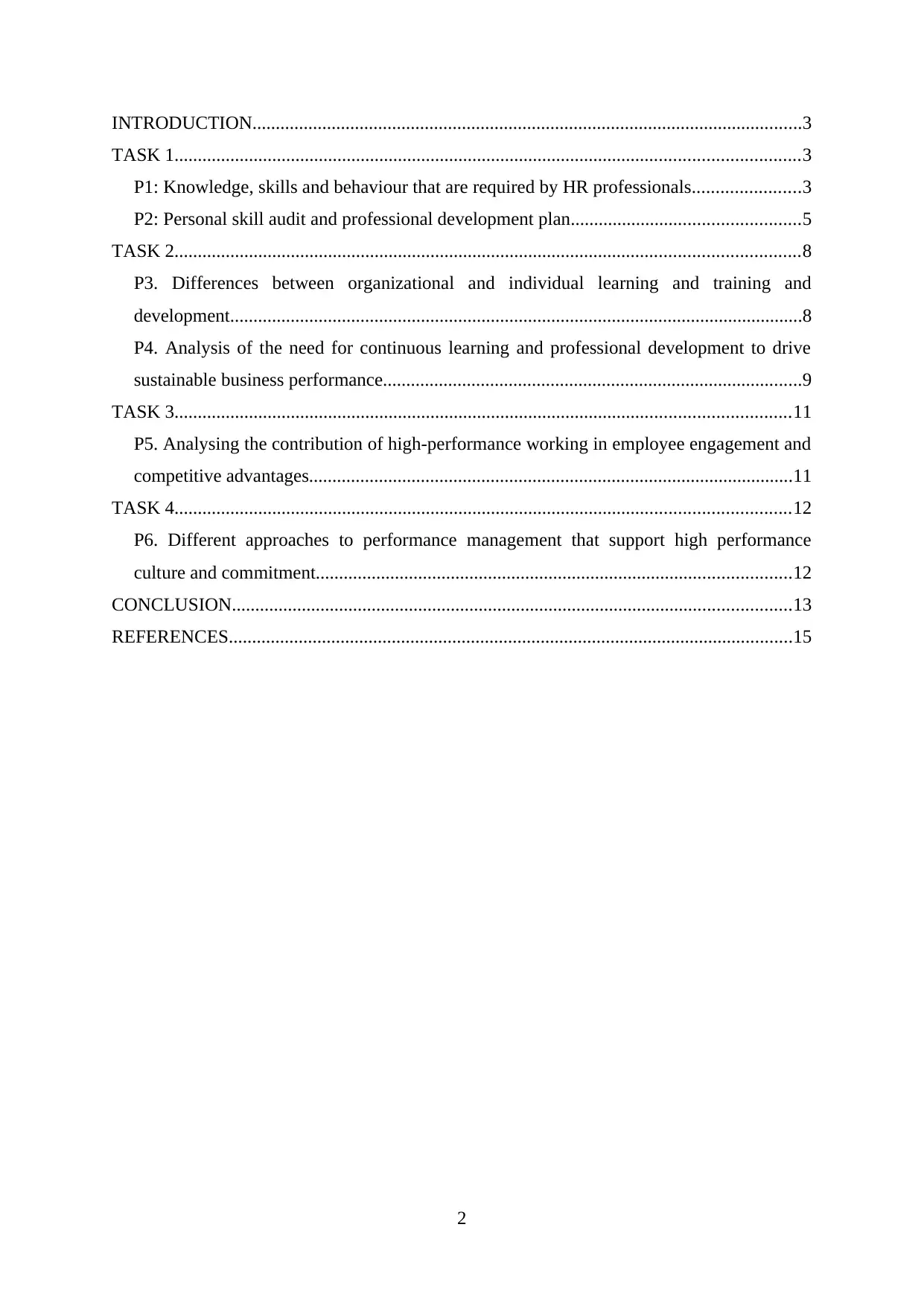
INTRODUCTION......................................................................................................................3
TASK 1......................................................................................................................................3
P1: Knowledge, skills and behaviour that are required by HR professionals.......................3
P2: Personal skill audit and professional development plan.................................................5
TASK 2......................................................................................................................................8
P3. Differences between organizational and individual learning and training and
development...........................................................................................................................8
P4. Analysis of the need for continuous learning and professional development to drive
sustainable business performance..........................................................................................9
TASK 3....................................................................................................................................11
P5. Analysing the contribution of high-performance working in employee engagement and
competitive advantages........................................................................................................11
TASK 4....................................................................................................................................12
P6. Different approaches to performance management that support high performance
culture and commitment......................................................................................................12
CONCLUSION........................................................................................................................13
REFERENCES.........................................................................................................................15
2
TASK 1......................................................................................................................................3
P1: Knowledge, skills and behaviour that are required by HR professionals.......................3
P2: Personal skill audit and professional development plan.................................................5
TASK 2......................................................................................................................................8
P3. Differences between organizational and individual learning and training and
development...........................................................................................................................8
P4. Analysis of the need for continuous learning and professional development to drive
sustainable business performance..........................................................................................9
TASK 3....................................................................................................................................11
P5. Analysing the contribution of high-performance working in employee engagement and
competitive advantages........................................................................................................11
TASK 4....................................................................................................................................12
P6. Different approaches to performance management that support high performance
culture and commitment......................................................................................................12
CONCLUSION........................................................................................................................13
REFERENCES.........................................................................................................................15
2
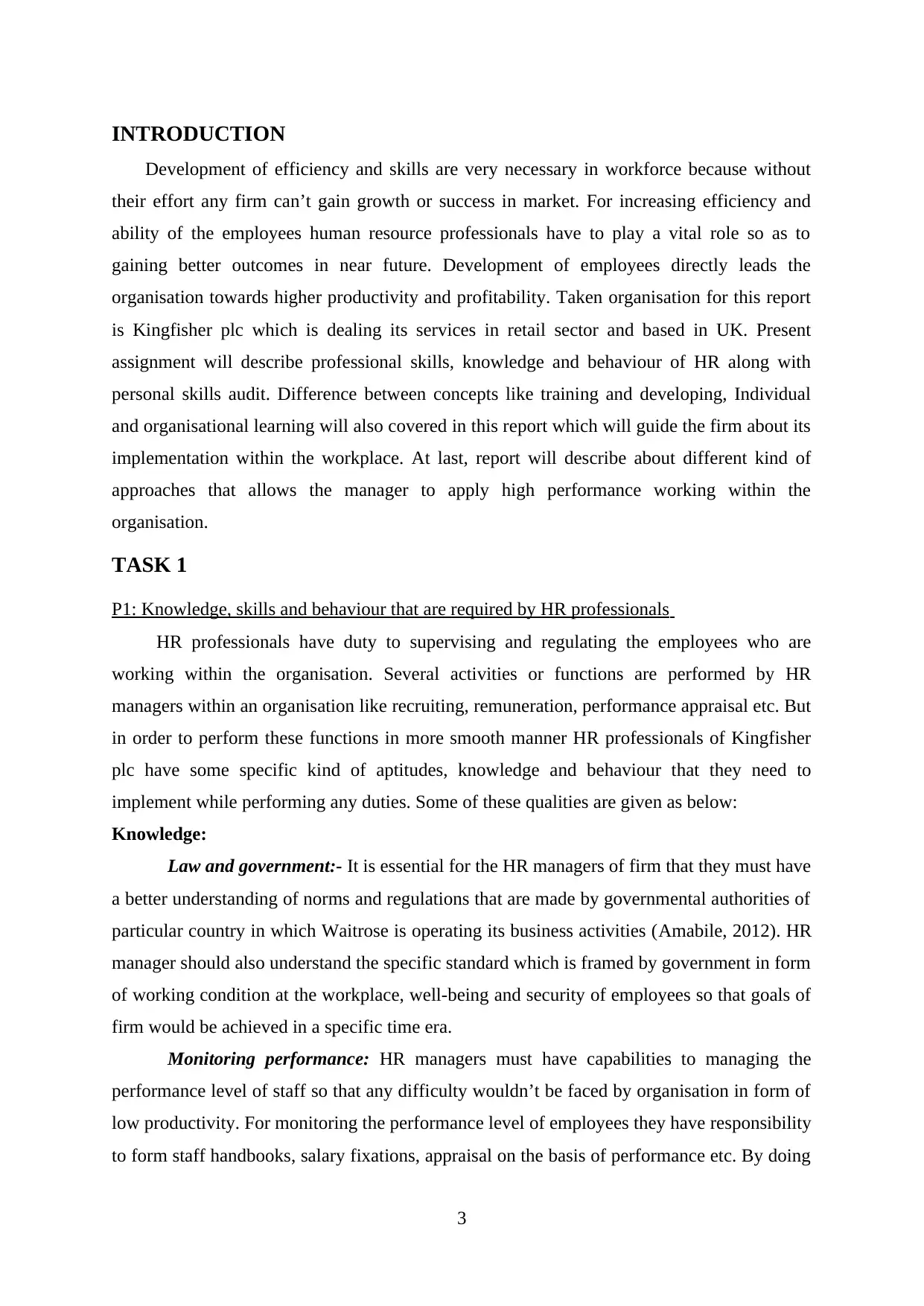
INTRODUCTION
Development of efficiency and skills are very necessary in workforce because without
their effort any firm can’t gain growth or success in market. For increasing efficiency and
ability of the employees human resource professionals have to play a vital role so as to
gaining better outcomes in near future. Development of employees directly leads the
organisation towards higher productivity and profitability. Taken organisation for this report
is Kingfisher plc which is dealing its services in retail sector and based in UK. Present
assignment will describe professional skills, knowledge and behaviour of HR along with
personal skills audit. Difference between concepts like training and developing, Individual
and organisational learning will also covered in this report which will guide the firm about its
implementation within the workplace. At last, report will describe about different kind of
approaches that allows the manager to apply high performance working within the
organisation.
TASK 1
P1: Knowledge, skills and behaviour that are required by HR professionals
HR professionals have duty to supervising and regulating the employees who are
working within the organisation. Several activities or functions are performed by HR
managers within an organisation like recruiting, remuneration, performance appraisal etc. But
in order to perform these functions in more smooth manner HR professionals of Kingfisher
plc have some specific kind of aptitudes, knowledge and behaviour that they need to
implement while performing any duties. Some of these qualities are given as below:
Knowledge:
Law and government:- It is essential for the HR managers of firm that they must have
a better understanding of norms and regulations that are made by governmental authorities of
particular country in which Waitrose is operating its business activities (Amabile, 2012). HR
manager should also understand the specific standard which is framed by government in form
of working condition at the workplace, well-being and security of employees so that goals of
firm would be achieved in a specific time era.
Monitoring performance: HR managers must have capabilities to managing the
performance level of staff so that any difficulty wouldn’t be faced by organisation in form of
low productivity. For monitoring the performance level of employees they have responsibility
to form staff handbooks, salary fixations, appraisal on the basis of performance etc. By doing
3
Development of efficiency and skills are very necessary in workforce because without
their effort any firm can’t gain growth or success in market. For increasing efficiency and
ability of the employees human resource professionals have to play a vital role so as to
gaining better outcomes in near future. Development of employees directly leads the
organisation towards higher productivity and profitability. Taken organisation for this report
is Kingfisher plc which is dealing its services in retail sector and based in UK. Present
assignment will describe professional skills, knowledge and behaviour of HR along with
personal skills audit. Difference between concepts like training and developing, Individual
and organisational learning will also covered in this report which will guide the firm about its
implementation within the workplace. At last, report will describe about different kind of
approaches that allows the manager to apply high performance working within the
organisation.
TASK 1
P1: Knowledge, skills and behaviour that are required by HR professionals
HR professionals have duty to supervising and regulating the employees who are
working within the organisation. Several activities or functions are performed by HR
managers within an organisation like recruiting, remuneration, performance appraisal etc. But
in order to perform these functions in more smooth manner HR professionals of Kingfisher
plc have some specific kind of aptitudes, knowledge and behaviour that they need to
implement while performing any duties. Some of these qualities are given as below:
Knowledge:
Law and government:- It is essential for the HR managers of firm that they must have
a better understanding of norms and regulations that are made by governmental authorities of
particular country in which Waitrose is operating its business activities (Amabile, 2012). HR
manager should also understand the specific standard which is framed by government in form
of working condition at the workplace, well-being and security of employees so that goals of
firm would be achieved in a specific time era.
Monitoring performance: HR managers must have capabilities to managing the
performance level of staff so that any difficulty wouldn’t be faced by organisation in form of
low productivity. For monitoring the performance level of employees they have responsibility
to form staff handbooks, salary fixations, appraisal on the basis of performance etc. By doing
3
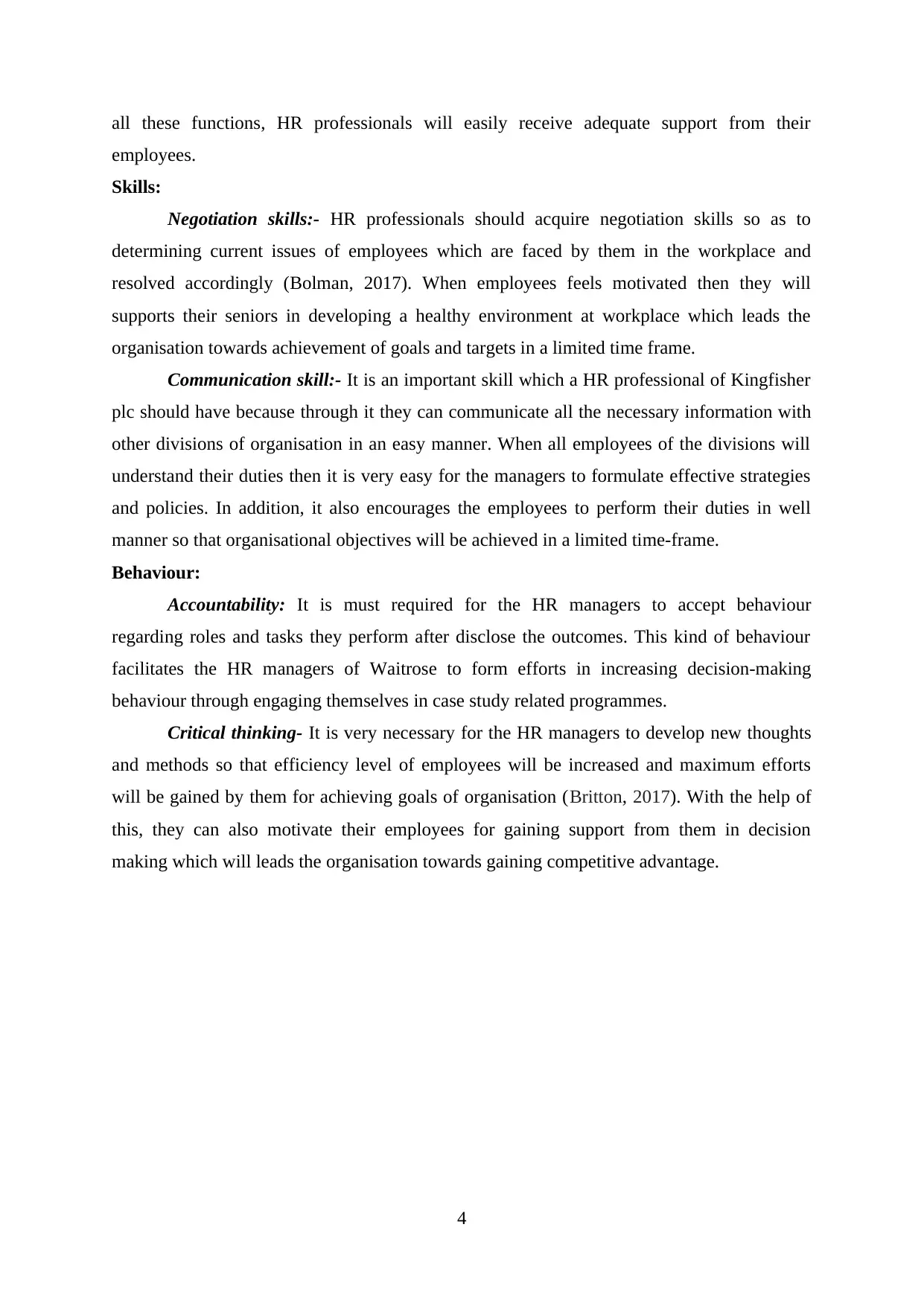
all these functions, HR professionals will easily receive adequate support from their
employees.
Skills:
Negotiation skills:- HR professionals should acquire negotiation skills so as to
determining current issues of employees which are faced by them in the workplace and
resolved accordingly (Bolman, 2017). When employees feels motivated then they will
supports their seniors in developing a healthy environment at workplace which leads the
organisation towards achievement of goals and targets in a limited time frame.
Communication skill:- It is an important skill which a HR professional of Kingfisher
plc should have because through it they can communicate all the necessary information with
other divisions of organisation in an easy manner. When all employees of the divisions will
understand their duties then it is very easy for the managers to formulate effective strategies
and policies. In addition, it also encourages the employees to perform their duties in well
manner so that organisational objectives will be achieved in a limited time-frame.
Behaviour:
Accountability: It is must required for the HR managers to accept behaviour
regarding roles and tasks they perform after disclose the outcomes. This kind of behaviour
facilitates the HR managers of Waitrose to form efforts in increasing decision-making
behaviour through engaging themselves in case study related programmes.
Critical thinking- It is very necessary for the HR managers to develop new thoughts
and methods so that efficiency level of employees will be increased and maximum efforts
will be gained by them for achieving goals of organisation (Britton, 2017). With the help of
this, they can also motivate their employees for gaining support from them in decision
making which will leads the organisation towards gaining competitive advantage.
4
employees.
Skills:
Negotiation skills:- HR professionals should acquire negotiation skills so as to
determining current issues of employees which are faced by them in the workplace and
resolved accordingly (Bolman, 2017). When employees feels motivated then they will
supports their seniors in developing a healthy environment at workplace which leads the
organisation towards achievement of goals and targets in a limited time frame.
Communication skill:- It is an important skill which a HR professional of Kingfisher
plc should have because through it they can communicate all the necessary information with
other divisions of organisation in an easy manner. When all employees of the divisions will
understand their duties then it is very easy for the managers to formulate effective strategies
and policies. In addition, it also encourages the employees to perform their duties in well
manner so that organisational objectives will be achieved in a limited time-frame.
Behaviour:
Accountability: It is must required for the HR managers to accept behaviour
regarding roles and tasks they perform after disclose the outcomes. This kind of behaviour
facilitates the HR managers of Waitrose to form efforts in increasing decision-making
behaviour through engaging themselves in case study related programmes.
Critical thinking- It is very necessary for the HR managers to develop new thoughts
and methods so that efficiency level of employees will be increased and maximum efforts
will be gained by them for achieving goals of organisation (Britton, 2017). With the help of
this, they can also motivate their employees for gaining support from them in decision
making which will leads the organisation towards gaining competitive advantage.
4
Secure Best Marks with AI Grader
Need help grading? Try our AI Grader for instant feedback on your assignments.
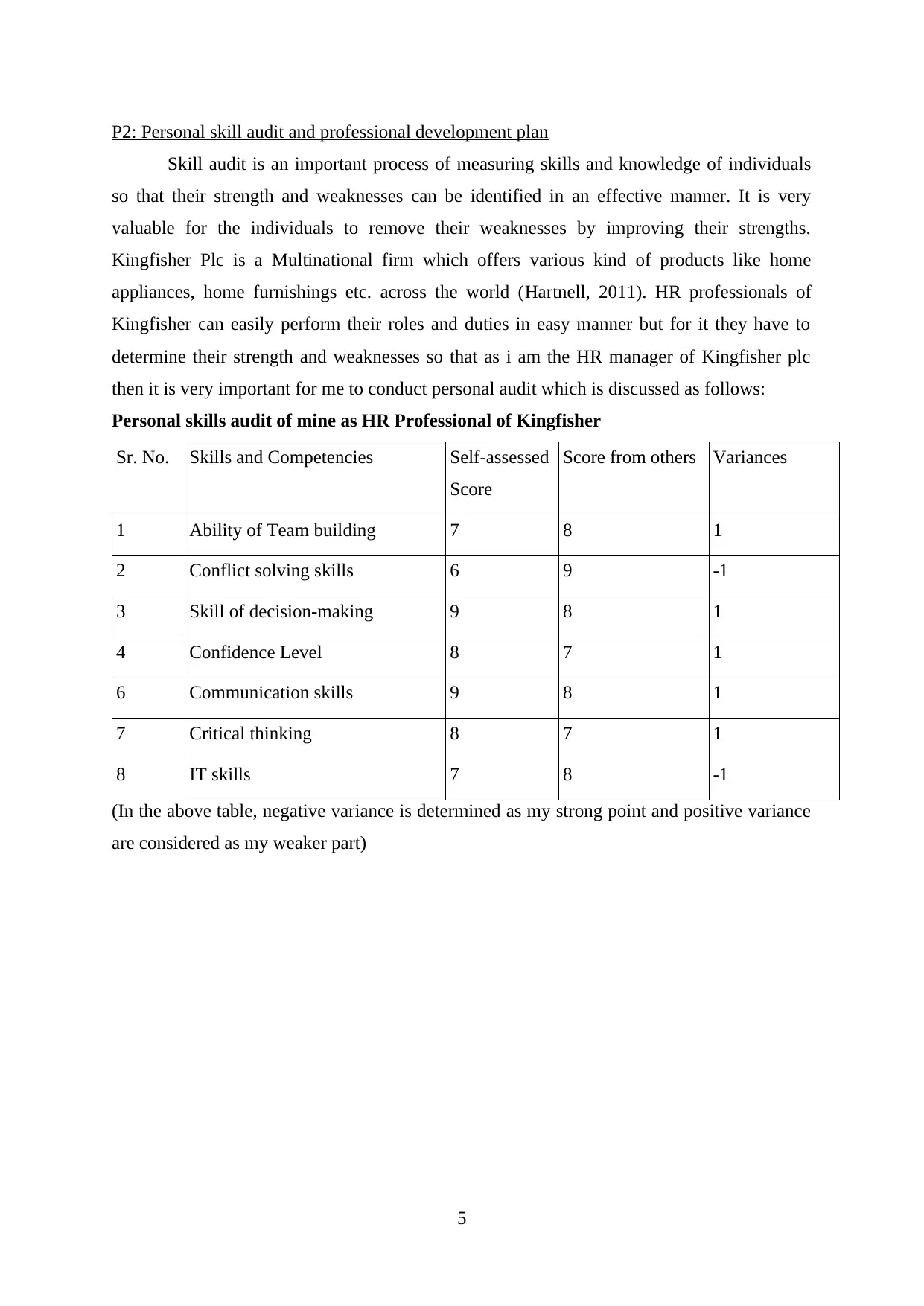
P2: Personal skill audit and professional development plan
Skill audit is an important process of measuring skills and knowledge of individuals
so that their strength and weaknesses can be identified in an effective manner. It is very
valuable for the individuals to remove their weaknesses by improving their strengths.
Kingfisher Plc is a Multinational firm which offers various kind of products like home
appliances, home furnishings etc. across the world (Hartnell, 2011). HR professionals of
Kingfisher can easily perform their roles and duties in easy manner but for it they have to
determine their strength and weaknesses so that as i am the HR manager of Kingfisher plc
then it is very important for me to conduct personal audit which is discussed as follows:
Personal skills audit of mine as HR Professional of Kingfisher
Sr. No. Skills and Competencies Self-assessed
Score
Score from others Variances
1 Ability of Team building 7 8 1
2 Conflict solving skills 6 9 -1
3 Skill of decision-making 9 8 1
4 Confidence Level 8 7 1
6 Communication skills 9 8 1
7 Critical thinking 8 7 1
8 IT skills 7 8 -1
(In the above table, negative variance is determined as my strong point and positive variance
are considered as my weaker part)
5
Skill audit is an important process of measuring skills and knowledge of individuals
so that their strength and weaknesses can be identified in an effective manner. It is very
valuable for the individuals to remove their weaknesses by improving their strengths.
Kingfisher Plc is a Multinational firm which offers various kind of products like home
appliances, home furnishings etc. across the world (Hartnell, 2011). HR professionals of
Kingfisher can easily perform their roles and duties in easy manner but for it they have to
determine their strength and weaknesses so that as i am the HR manager of Kingfisher plc
then it is very important for me to conduct personal audit which is discussed as follows:
Personal skills audit of mine as HR Professional of Kingfisher
Sr. No. Skills and Competencies Self-assessed
Score
Score from others Variances
1 Ability of Team building 7 8 1
2 Conflict solving skills 6 9 -1
3 Skill of decision-making 9 8 1
4 Confidence Level 8 7 1
6 Communication skills 9 8 1
7 Critical thinking 8 7 1
8 IT skills 7 8 -1
(In the above table, negative variance is determined as my strong point and positive variance
are considered as my weaker part)
5
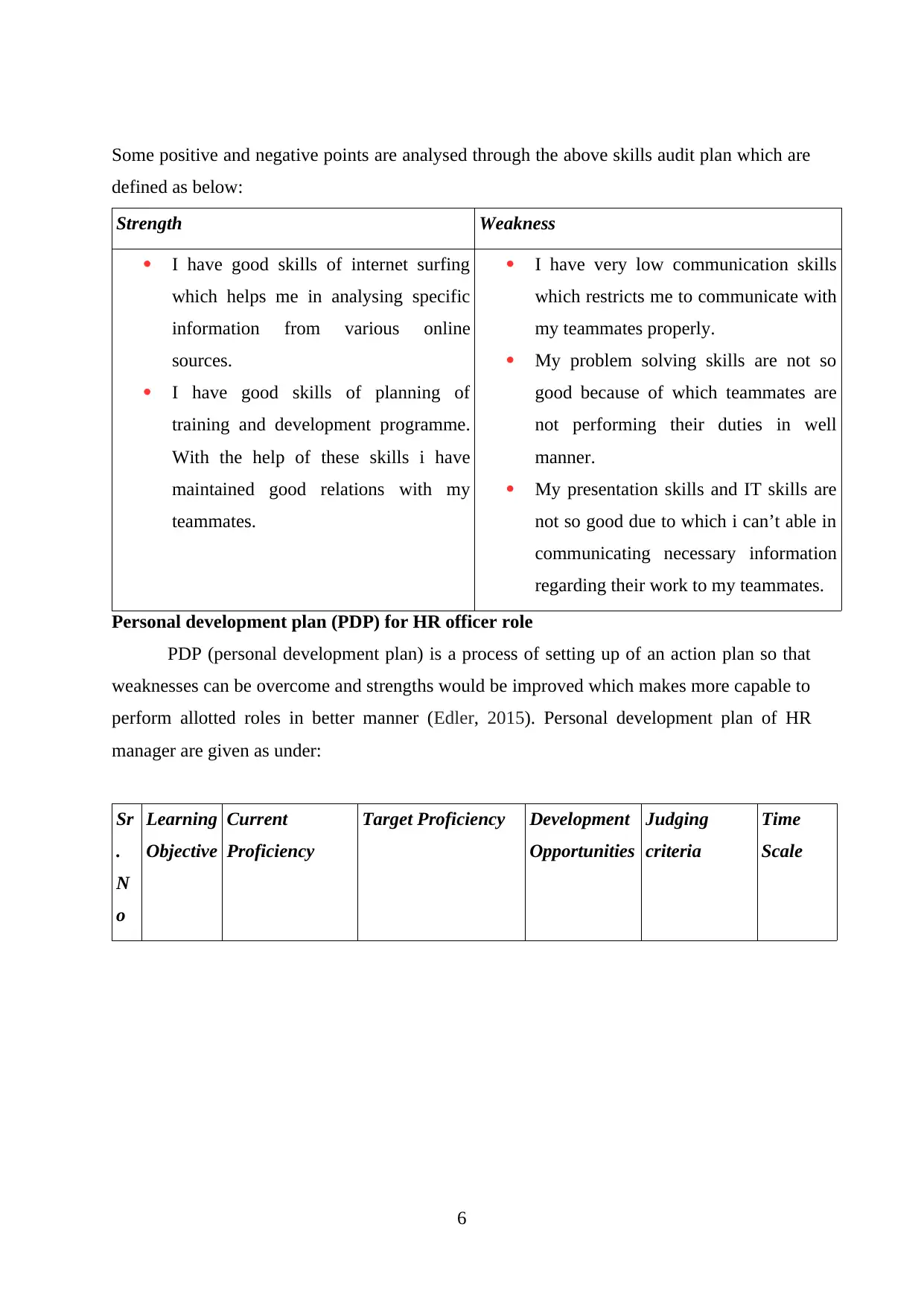
Some positive and negative points are analysed through the above skills audit plan which are
defined as below:
Strength Weakness
I have good skills of internet surfing
which helps me in analysing specific
information from various online
sources.
I have good skills of planning of
training and development programme.
With the help of these skills i have
maintained good relations with my
teammates.
I have very low communication skills
which restricts me to communicate with
my teammates properly.
My problem solving skills are not so
good because of which teammates are
not performing their duties in well
manner.
My presentation skills and IT skills are
not so good due to which i can’t able in
communicating necessary information
regarding their work to my teammates.
Personal development plan (PDP) for HR officer role
PDP (personal development plan) is a process of setting up of an action plan so that
weaknesses can be overcome and strengths would be improved which makes more capable to
perform allotted roles in better manner (Edler, 2015). Personal development plan of HR
manager are given as under:
Sr
.
N
o
Learning
Objective
Current
Proficiency
Target Proficiency Development
Opportunities
Judging
criteria
Time
Scale
6
defined as below:
Strength Weakness
I have good skills of internet surfing
which helps me in analysing specific
information from various online
sources.
I have good skills of planning of
training and development programme.
With the help of these skills i have
maintained good relations with my
teammates.
I have very low communication skills
which restricts me to communicate with
my teammates properly.
My problem solving skills are not so
good because of which teammates are
not performing their duties in well
manner.
My presentation skills and IT skills are
not so good due to which i can’t able in
communicating necessary information
regarding their work to my teammates.
Personal development plan (PDP) for HR officer role
PDP (personal development plan) is a process of setting up of an action plan so that
weaknesses can be overcome and strengths would be improved which makes more capable to
perform allotted roles in better manner (Edler, 2015). Personal development plan of HR
manager are given as under:
Sr
.
N
o
Learning
Objective
Current
Proficiency
Target Proficiency Development
Opportunities
Judging
criteria
Time
Scale
6
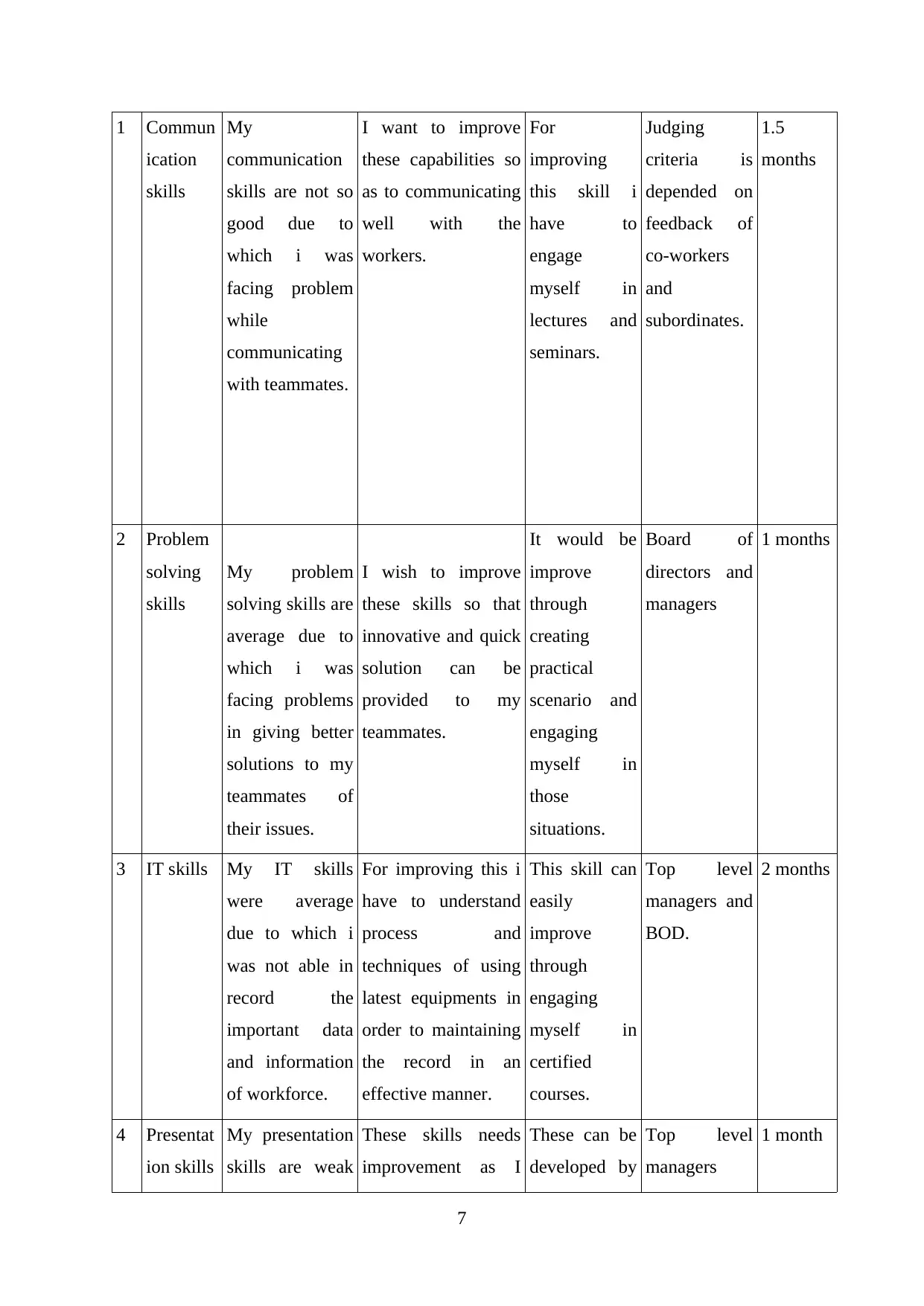
1 Commun
ication
skills
My
communication
skills are not so
good due to
which i was
facing problem
while
communicating
with teammates.
I want to improve
these capabilities so
as to communicating
well with the
workers.
For
improving
this skill i
have to
engage
myself in
lectures and
seminars.
Judging
criteria is
depended on
feedback of
co-workers
and
subordinates.
1.5
months
2 Problem
solving
skills
My problem
solving skills are
average due to
which i was
facing problems
in giving better
solutions to my
teammates of
their issues.
I wish to improve
these skills so that
innovative and quick
solution can be
provided to my
teammates.
It would be
improve
through
creating
practical
scenario and
engaging
myself in
those
situations.
Board of
directors and
managers
1 months
3 IT skills My IT skills
were average
due to which i
was not able in
record the
important data
and information
of workforce.
For improving this i
have to understand
process and
techniques of using
latest equipments in
order to maintaining
the record in an
effective manner.
This skill can
easily
improve
through
engaging
myself in
certified
courses.
Top level
managers and
BOD.
2 months
4 Presentat
ion skills
My presentation
skills are weak
These skills needs
improvement as I
These can be
developed by
Top level
managers
1 month
7
ication
skills
My
communication
skills are not so
good due to
which i was
facing problem
while
communicating
with teammates.
I want to improve
these capabilities so
as to communicating
well with the
workers.
For
improving
this skill i
have to
engage
myself in
lectures and
seminars.
Judging
criteria is
depended on
feedback of
co-workers
and
subordinates.
1.5
months
2 Problem
solving
skills
My problem
solving skills are
average due to
which i was
facing problems
in giving better
solutions to my
teammates of
their issues.
I wish to improve
these skills so that
innovative and quick
solution can be
provided to my
teammates.
It would be
improve
through
creating
practical
scenario and
engaging
myself in
those
situations.
Board of
directors and
managers
1 months
3 IT skills My IT skills
were average
due to which i
was not able in
record the
important data
and information
of workforce.
For improving this i
have to understand
process and
techniques of using
latest equipments in
order to maintaining
the record in an
effective manner.
This skill can
easily
improve
through
engaging
myself in
certified
courses.
Top level
managers and
BOD.
2 months
4 Presentat
ion skills
My presentation
skills are weak
These skills needs
improvement as I
These can be
developed by
Top level
managers
1 month
7
Paraphrase This Document
Need a fresh take? Get an instant paraphrase of this document with our AI Paraphraser
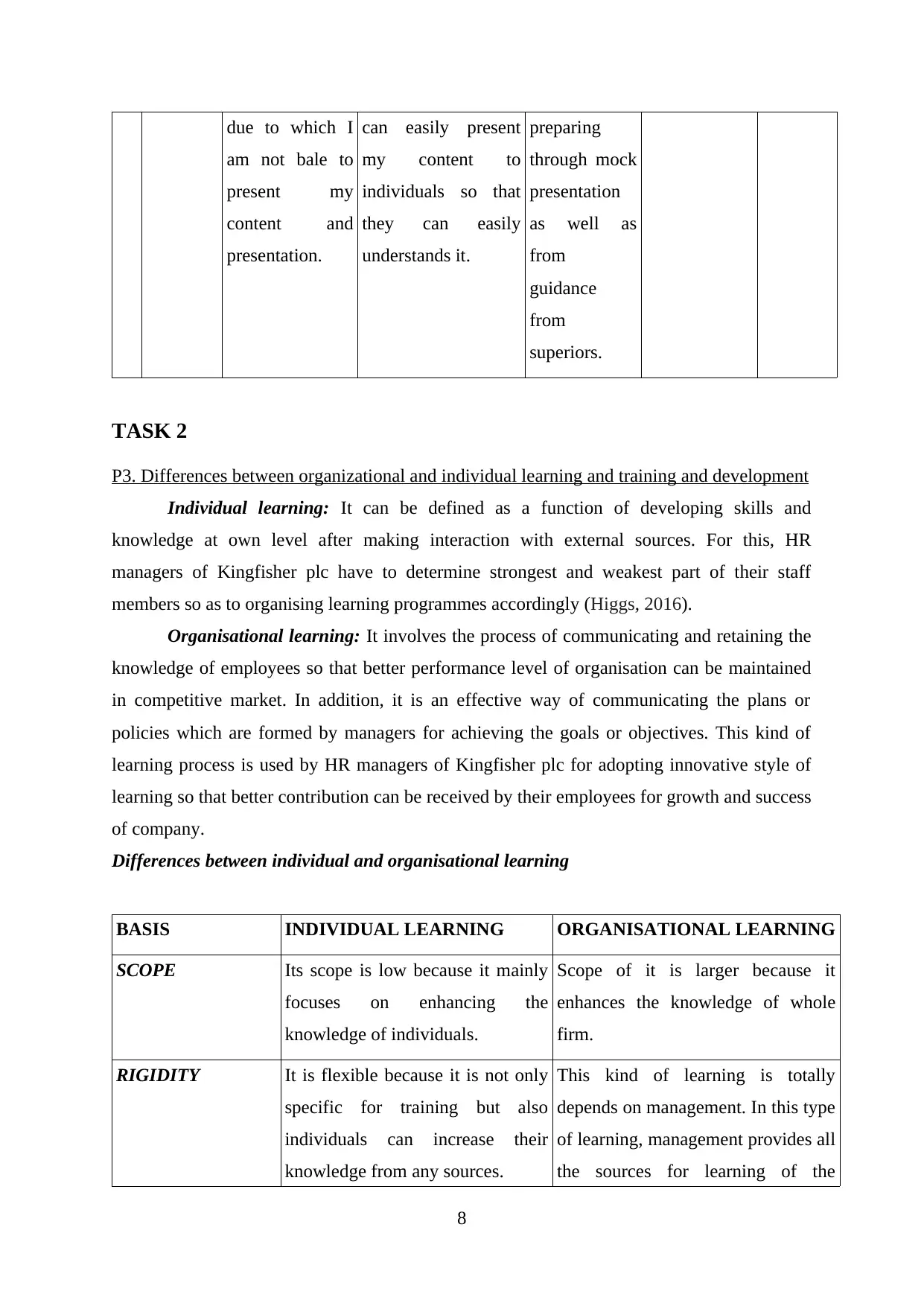
due to which I
am not bale to
present my
content and
presentation.
can easily present
my content to
individuals so that
they can easily
understands it.
preparing
through mock
presentation
as well as
from
guidance
from
superiors.
TASK 2
P3. Differences between organizational and individual learning and training and development
Individual learning: It can be defined as a function of developing skills and
knowledge at own level after making interaction with external sources. For this, HR
managers of Kingfisher plc have to determine strongest and weakest part of their staff
members so as to organising learning programmes accordingly (Higgs, 2016).
Organisational learning: It involves the process of communicating and retaining the
knowledge of employees so that better performance level of organisation can be maintained
in competitive market. In addition, it is an effective way of communicating the plans or
policies which are formed by managers for achieving the goals or objectives. This kind of
learning process is used by HR managers of Kingfisher plc for adopting innovative style of
learning so that better contribution can be received by their employees for growth and success
of company.
Differences between individual and organisational learning
BASIS INDIVIDUAL LEARNING ORGANISATIONAL LEARNING
SCOPE Its scope is low because it mainly
focuses on enhancing the
knowledge of individuals.
Scope of it is larger because it
enhances the knowledge of whole
firm.
RIGIDITY It is flexible because it is not only
specific for training but also
individuals can increase their
knowledge from any sources.
This kind of learning is totally
depends on management. In this type
of learning, management provides all
the sources for learning of the
8
am not bale to
present my
content and
presentation.
can easily present
my content to
individuals so that
they can easily
understands it.
preparing
through mock
presentation
as well as
from
guidance
from
superiors.
TASK 2
P3. Differences between organizational and individual learning and training and development
Individual learning: It can be defined as a function of developing skills and
knowledge at own level after making interaction with external sources. For this, HR
managers of Kingfisher plc have to determine strongest and weakest part of their staff
members so as to organising learning programmes accordingly (Higgs, 2016).
Organisational learning: It involves the process of communicating and retaining the
knowledge of employees so that better performance level of organisation can be maintained
in competitive market. In addition, it is an effective way of communicating the plans or
policies which are formed by managers for achieving the goals or objectives. This kind of
learning process is used by HR managers of Kingfisher plc for adopting innovative style of
learning so that better contribution can be received by their employees for growth and success
of company.
Differences between individual and organisational learning
BASIS INDIVIDUAL LEARNING ORGANISATIONAL LEARNING
SCOPE Its scope is low because it mainly
focuses on enhancing the
knowledge of individuals.
Scope of it is larger because it
enhances the knowledge of whole
firm.
RIGIDITY It is flexible because it is not only
specific for training but also
individuals can increase their
knowledge from any sources.
This kind of learning is totally
depends on management. In this type
of learning, management provides all
the sources for learning of the
8
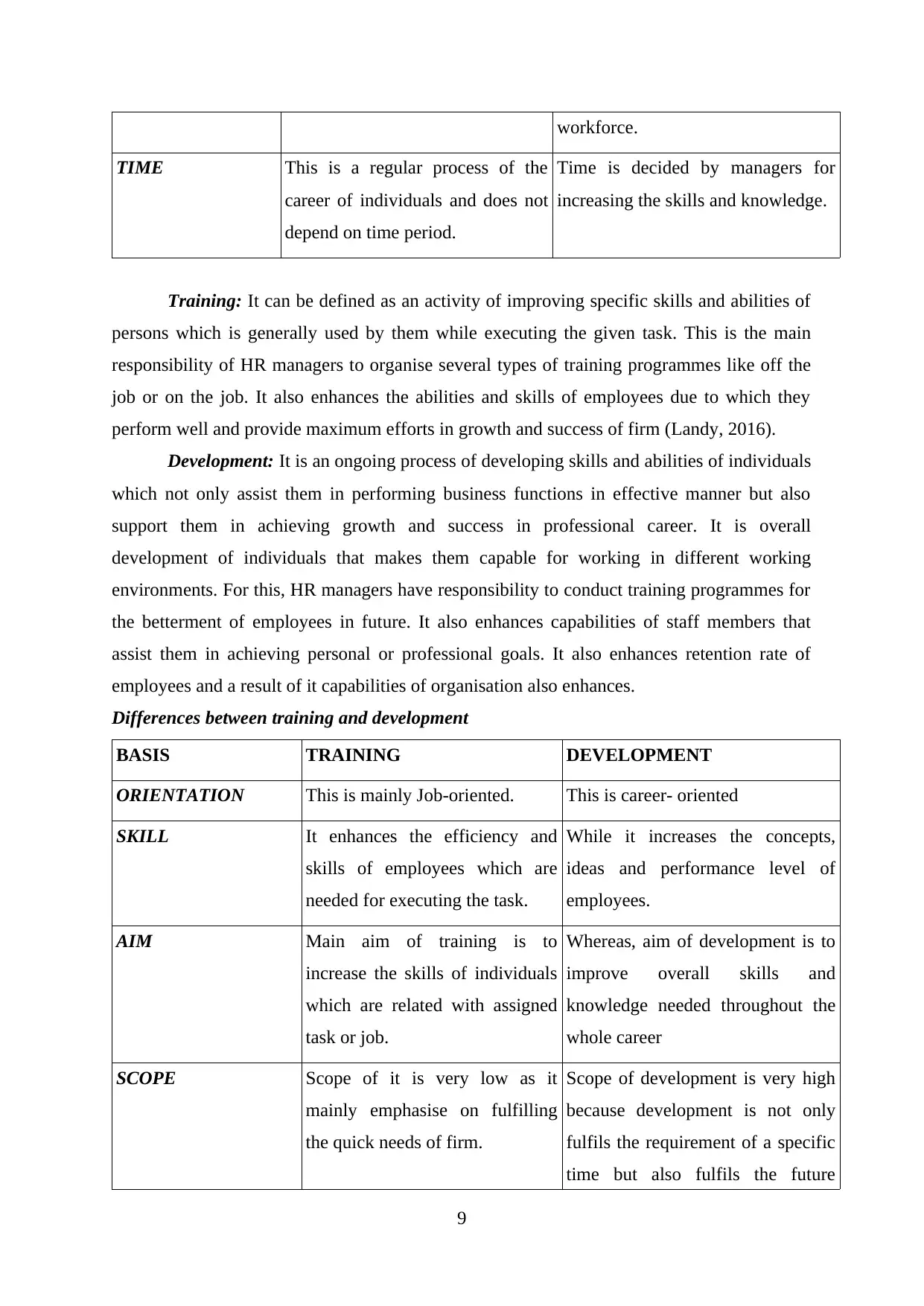
workforce.
TIME This is a regular process of the
career of individuals and does not
depend on time period.
Time is decided by managers for
increasing the skills and knowledge.
Training: It can be defined as an activity of improving specific skills and abilities of
persons which is generally used by them while executing the given task. This is the main
responsibility of HR managers to organise several types of training programmes like off the
job or on the job. It also enhances the abilities and skills of employees due to which they
perform well and provide maximum efforts in growth and success of firm (Landy, 2016).
Development: It is an ongoing process of developing skills and abilities of individuals
which not only assist them in performing business functions in effective manner but also
support them in achieving growth and success in professional career. It is overall
development of individuals that makes them capable for working in different working
environments. For this, HR managers have responsibility to conduct training programmes for
the betterment of employees in future. It also enhances capabilities of staff members that
assist them in achieving personal or professional goals. It also enhances retention rate of
employees and a result of it capabilities of organisation also enhances.
Differences between training and development
BASIS TRAINING DEVELOPMENT
ORIENTATION This is mainly Job-oriented. This is career- oriented
SKILL It enhances the efficiency and
skills of employees which are
needed for executing the task.
While it increases the concepts,
ideas and performance level of
employees.
AIM Main aim of training is to
increase the skills of individuals
which are related with assigned
task or job.
Whereas, aim of development is to
improve overall skills and
knowledge needed throughout the
whole career
SCOPE Scope of it is very low as it
mainly emphasise on fulfilling
the quick needs of firm.
Scope of development is very high
because development is not only
fulfils the requirement of a specific
time but also fulfils the future
9
TIME This is a regular process of the
career of individuals and does not
depend on time period.
Time is decided by managers for
increasing the skills and knowledge.
Training: It can be defined as an activity of improving specific skills and abilities of
persons which is generally used by them while executing the given task. This is the main
responsibility of HR managers to organise several types of training programmes like off the
job or on the job. It also enhances the abilities and skills of employees due to which they
perform well and provide maximum efforts in growth and success of firm (Landy, 2016).
Development: It is an ongoing process of developing skills and abilities of individuals
which not only assist them in performing business functions in effective manner but also
support them in achieving growth and success in professional career. It is overall
development of individuals that makes them capable for working in different working
environments. For this, HR managers have responsibility to conduct training programmes for
the betterment of employees in future. It also enhances capabilities of staff members that
assist them in achieving personal or professional goals. It also enhances retention rate of
employees and a result of it capabilities of organisation also enhances.
Differences between training and development
BASIS TRAINING DEVELOPMENT
ORIENTATION This is mainly Job-oriented. This is career- oriented
SKILL It enhances the efficiency and
skills of employees which are
needed for executing the task.
While it increases the concepts,
ideas and performance level of
employees.
AIM Main aim of training is to
increase the skills of individuals
which are related with assigned
task or job.
Whereas, aim of development is to
improve overall skills and
knowledge needed throughout the
whole career
SCOPE Scope of it is very low as it
mainly emphasise on fulfilling
the quick needs of firm.
Scope of development is very high
because development is not only
fulfils the requirement of a specific
time but also fulfils the future
9
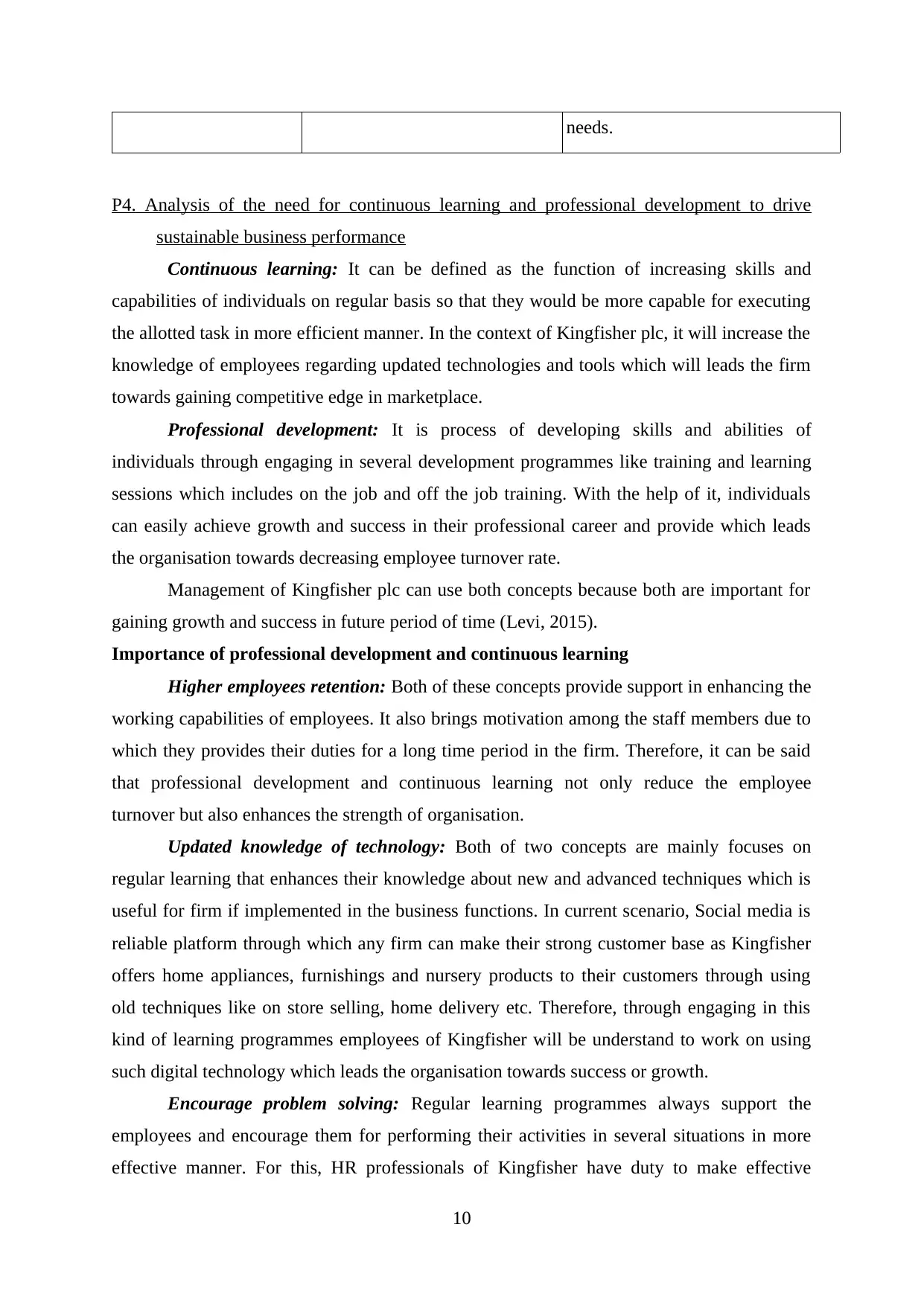
needs.
P4. Analysis of the need for continuous learning and professional development to drive
sustainable business performance
Continuous learning: It can be defined as the function of increasing skills and
capabilities of individuals on regular basis so that they would be more capable for executing
the allotted task in more efficient manner. In the context of Kingfisher plc, it will increase the
knowledge of employees regarding updated technologies and tools which will leads the firm
towards gaining competitive edge in marketplace.
Professional development: It is process of developing skills and abilities of
individuals through engaging in several development programmes like training and learning
sessions which includes on the job and off the job training. With the help of it, individuals
can easily achieve growth and success in their professional career and provide which leads
the organisation towards decreasing employee turnover rate.
Management of Kingfisher plc can use both concepts because both are important for
gaining growth and success in future period of time (Levi, 2015).
Importance of professional development and continuous learning
Higher employees retention: Both of these concepts provide support in enhancing the
working capabilities of employees. It also brings motivation among the staff members due to
which they provides their duties for a long time period in the firm. Therefore, it can be said
that professional development and continuous learning not only reduce the employee
turnover but also enhances the strength of organisation.
Updated knowledge of technology: Both of two concepts are mainly focuses on
regular learning that enhances their knowledge about new and advanced techniques which is
useful for firm if implemented in the business functions. In current scenario, Social media is
reliable platform through which any firm can make their strong customer base as Kingfisher
offers home appliances, furnishings and nursery products to their customers through using
old techniques like on store selling, home delivery etc. Therefore, through engaging in this
kind of learning programmes employees of Kingfisher will be understand to work on using
such digital technology which leads the organisation towards success or growth.
Encourage problem solving: Regular learning programmes always support the
employees and encourage them for performing their activities in several situations in more
effective manner. For this, HR professionals of Kingfisher have duty to make effective
10
P4. Analysis of the need for continuous learning and professional development to drive
sustainable business performance
Continuous learning: It can be defined as the function of increasing skills and
capabilities of individuals on regular basis so that they would be more capable for executing
the allotted task in more efficient manner. In the context of Kingfisher plc, it will increase the
knowledge of employees regarding updated technologies and tools which will leads the firm
towards gaining competitive edge in marketplace.
Professional development: It is process of developing skills and abilities of
individuals through engaging in several development programmes like training and learning
sessions which includes on the job and off the job training. With the help of it, individuals
can easily achieve growth and success in their professional career and provide which leads
the organisation towards decreasing employee turnover rate.
Management of Kingfisher plc can use both concepts because both are important for
gaining growth and success in future period of time (Levi, 2015).
Importance of professional development and continuous learning
Higher employees retention: Both of these concepts provide support in enhancing the
working capabilities of employees. It also brings motivation among the staff members due to
which they provides their duties for a long time period in the firm. Therefore, it can be said
that professional development and continuous learning not only reduce the employee
turnover but also enhances the strength of organisation.
Updated knowledge of technology: Both of two concepts are mainly focuses on
regular learning that enhances their knowledge about new and advanced techniques which is
useful for firm if implemented in the business functions. In current scenario, Social media is
reliable platform through which any firm can make their strong customer base as Kingfisher
offers home appliances, furnishings and nursery products to their customers through using
old techniques like on store selling, home delivery etc. Therefore, through engaging in this
kind of learning programmes employees of Kingfisher will be understand to work on using
such digital technology which leads the organisation towards success or growth.
Encourage problem solving: Regular learning programmes always support the
employees and encourage them for performing their activities in several situations in more
effective manner. For this, HR professionals of Kingfisher have duty to make effective
10
Secure Best Marks with AI Grader
Need help grading? Try our AI Grader for instant feedback on your assignments.
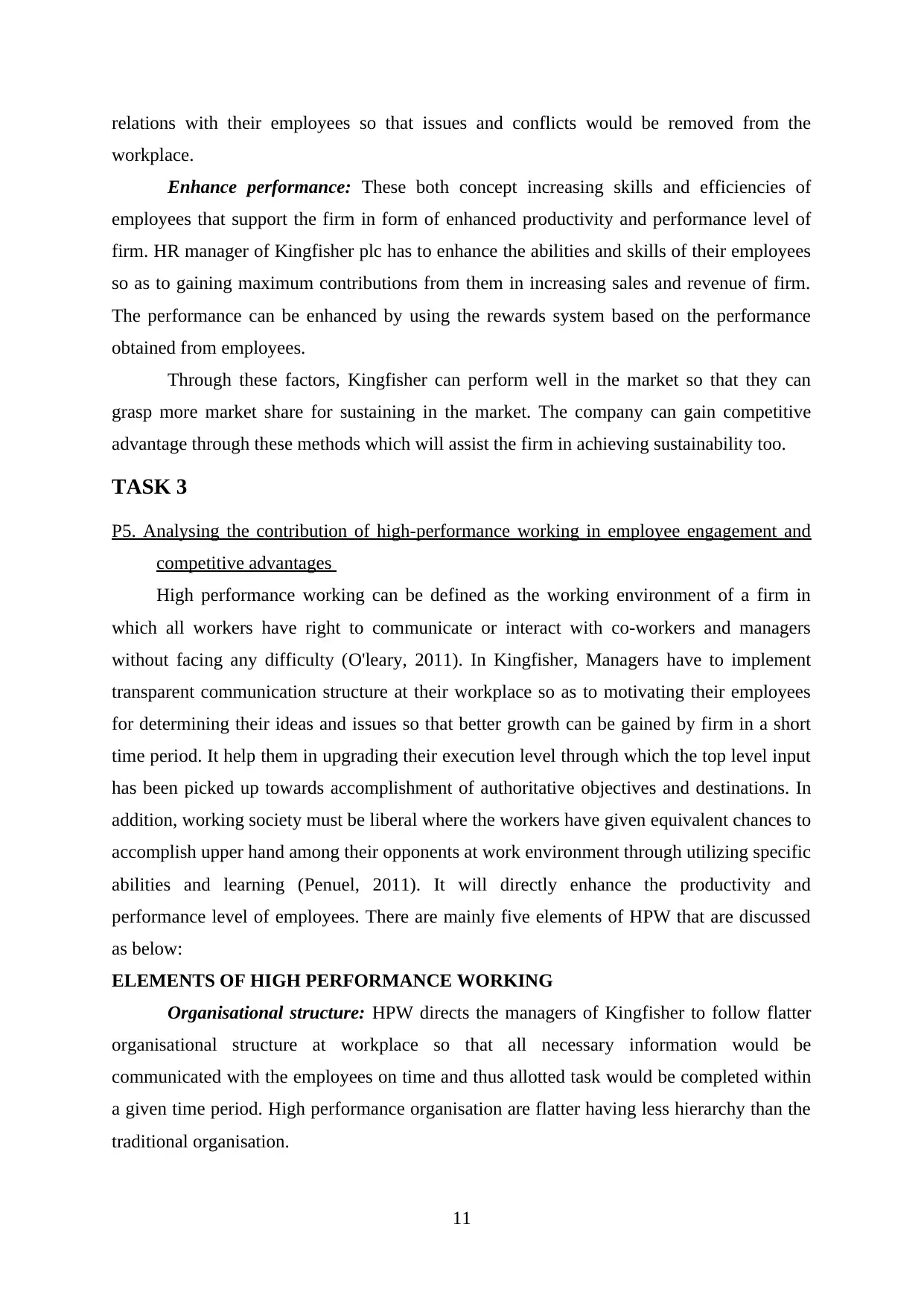
relations with their employees so that issues and conflicts would be removed from the
workplace.
Enhance performance: These both concept increasing skills and efficiencies of
employees that support the firm in form of enhanced productivity and performance level of
firm. HR manager of Kingfisher plc has to enhance the abilities and skills of their employees
so as to gaining maximum contributions from them in increasing sales and revenue of firm.
The performance can be enhanced by using the rewards system based on the performance
obtained from employees.
Through these factors, Kingfisher can perform well in the market so that they can
grasp more market share for sustaining in the market. The company can gain competitive
advantage through these methods which will assist the firm in achieving sustainability too.
TASK 3
P5. Analysing the contribution of high-performance working in employee engagement and
competitive advantages
High performance working can be defined as the working environment of a firm in
which all workers have right to communicate or interact with co-workers and managers
without facing any difficulty (O'leary, 2011). In Kingfisher, Managers have to implement
transparent communication structure at their workplace so as to motivating their employees
for determining their ideas and issues so that better growth can be gained by firm in a short
time period. It help them in upgrading their execution level through which the top level input
has been picked up towards accomplishment of authoritative objectives and destinations. In
addition, working society must be liberal where the workers have given equivalent chances to
accomplish upper hand among their opponents at work environment through utilizing specific
abilities and learning (Penuel, 2011). It will directly enhance the productivity and
performance level of employees. There are mainly five elements of HPW that are discussed
as below:
ELEMENTS OF HIGH PERFORMANCE WORKING
Organisational structure: HPW directs the managers of Kingfisher to follow flatter
organisational structure at workplace so that all necessary information would be
communicated with the employees on time and thus allotted task would be completed within
a given time period. High performance organisation are flatter having less hierarchy than the
traditional organisation.
11
workplace.
Enhance performance: These both concept increasing skills and efficiencies of
employees that support the firm in form of enhanced productivity and performance level of
firm. HR manager of Kingfisher plc has to enhance the abilities and skills of their employees
so as to gaining maximum contributions from them in increasing sales and revenue of firm.
The performance can be enhanced by using the rewards system based on the performance
obtained from employees.
Through these factors, Kingfisher can perform well in the market so that they can
grasp more market share for sustaining in the market. The company can gain competitive
advantage through these methods which will assist the firm in achieving sustainability too.
TASK 3
P5. Analysing the contribution of high-performance working in employee engagement and
competitive advantages
High performance working can be defined as the working environment of a firm in
which all workers have right to communicate or interact with co-workers and managers
without facing any difficulty (O'leary, 2011). In Kingfisher, Managers have to implement
transparent communication structure at their workplace so as to motivating their employees
for determining their ideas and issues so that better growth can be gained by firm in a short
time period. It help them in upgrading their execution level through which the top level input
has been picked up towards accomplishment of authoritative objectives and destinations. In
addition, working society must be liberal where the workers have given equivalent chances to
accomplish upper hand among their opponents at work environment through utilizing specific
abilities and learning (Penuel, 2011). It will directly enhance the productivity and
performance level of employees. There are mainly five elements of HPW that are discussed
as below:
ELEMENTS OF HIGH PERFORMANCE WORKING
Organisational structure: HPW directs the managers of Kingfisher to follow flatter
organisational structure at workplace so that all necessary information would be
communicated with the employees on time and thus allotted task would be completed within
a given time period. High performance organisation are flatter having less hierarchy than the
traditional organisation.
11
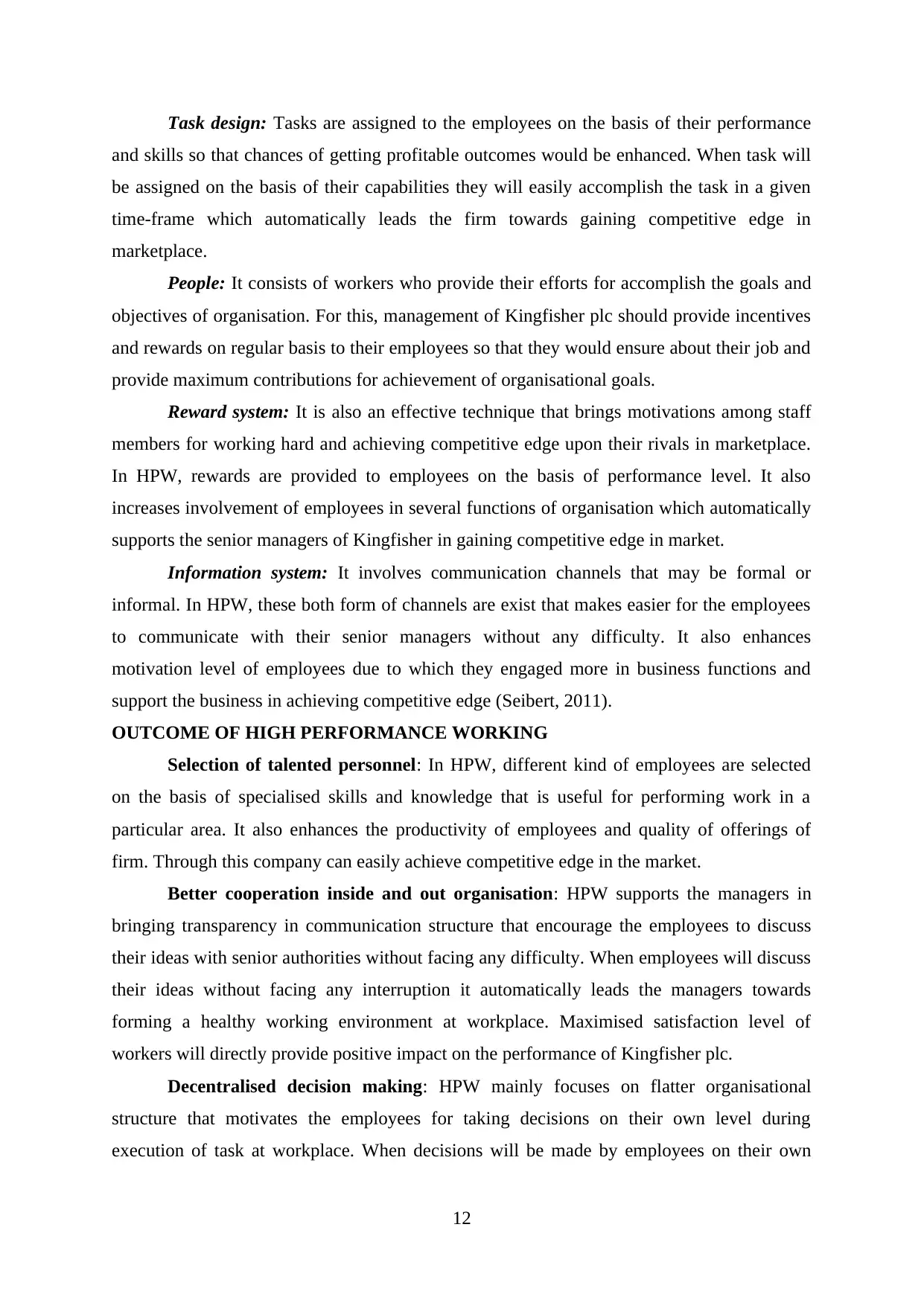
Task design: Tasks are assigned to the employees on the basis of their performance
and skills so that chances of getting profitable outcomes would be enhanced. When task will
be assigned on the basis of their capabilities they will easily accomplish the task in a given
time-frame which automatically leads the firm towards gaining competitive edge in
marketplace.
People: It consists of workers who provide their efforts for accomplish the goals and
objectives of organisation. For this, management of Kingfisher plc should provide incentives
and rewards on regular basis to their employees so that they would ensure about their job and
provide maximum contributions for achievement of organisational goals.
Reward system: It is also an effective technique that brings motivations among staff
members for working hard and achieving competitive edge upon their rivals in marketplace.
In HPW, rewards are provided to employees on the basis of performance level. It also
increases involvement of employees in several functions of organisation which automatically
supports the senior managers of Kingfisher in gaining competitive edge in market.
Information system: It involves communication channels that may be formal or
informal. In HPW, these both form of channels are exist that makes easier for the employees
to communicate with their senior managers without any difficulty. It also enhances
motivation level of employees due to which they engaged more in business functions and
support the business in achieving competitive edge (Seibert, 2011).
OUTCOME OF HIGH PERFORMANCE WORKING
Selection of talented personnel: In HPW, different kind of employees are selected
on the basis of specialised skills and knowledge that is useful for performing work in a
particular area. It also enhances the productivity of employees and quality of offerings of
firm. Through this company can easily achieve competitive edge in the market.
Better cooperation inside and out organisation: HPW supports the managers in
bringing transparency in communication structure that encourage the employees to discuss
their ideas with senior authorities without facing any difficulty. When employees will discuss
their ideas without facing any interruption it automatically leads the managers towards
forming a healthy working environment at workplace. Maximised satisfaction level of
workers will directly provide positive impact on the performance of Kingfisher plc.
Decentralised decision making: HPW mainly focuses on flatter organisational
structure that motivates the employees for taking decisions on their own level during
execution of task at workplace. When decisions will be made by employees on their own
12
and skills so that chances of getting profitable outcomes would be enhanced. When task will
be assigned on the basis of their capabilities they will easily accomplish the task in a given
time-frame which automatically leads the firm towards gaining competitive edge in
marketplace.
People: It consists of workers who provide their efforts for accomplish the goals and
objectives of organisation. For this, management of Kingfisher plc should provide incentives
and rewards on regular basis to their employees so that they would ensure about their job and
provide maximum contributions for achievement of organisational goals.
Reward system: It is also an effective technique that brings motivations among staff
members for working hard and achieving competitive edge upon their rivals in marketplace.
In HPW, rewards are provided to employees on the basis of performance level. It also
increases involvement of employees in several functions of organisation which automatically
supports the senior managers of Kingfisher in gaining competitive edge in market.
Information system: It involves communication channels that may be formal or
informal. In HPW, these both form of channels are exist that makes easier for the employees
to communicate with their senior managers without any difficulty. It also enhances
motivation level of employees due to which they engaged more in business functions and
support the business in achieving competitive edge (Seibert, 2011).
OUTCOME OF HIGH PERFORMANCE WORKING
Selection of talented personnel: In HPW, different kind of employees are selected
on the basis of specialised skills and knowledge that is useful for performing work in a
particular area. It also enhances the productivity of employees and quality of offerings of
firm. Through this company can easily achieve competitive edge in the market.
Better cooperation inside and out organisation: HPW supports the managers in
bringing transparency in communication structure that encourage the employees to discuss
their ideas with senior authorities without facing any difficulty. When employees will discuss
their ideas without facing any interruption it automatically leads the managers towards
forming a healthy working environment at workplace. Maximised satisfaction level of
workers will directly provide positive impact on the performance of Kingfisher plc.
Decentralised decision making: HPW mainly focuses on flatter organisational
structure that motivates the employees for taking decisions on their own level during
execution of task at workplace. When decisions will be made by employees on their own
12
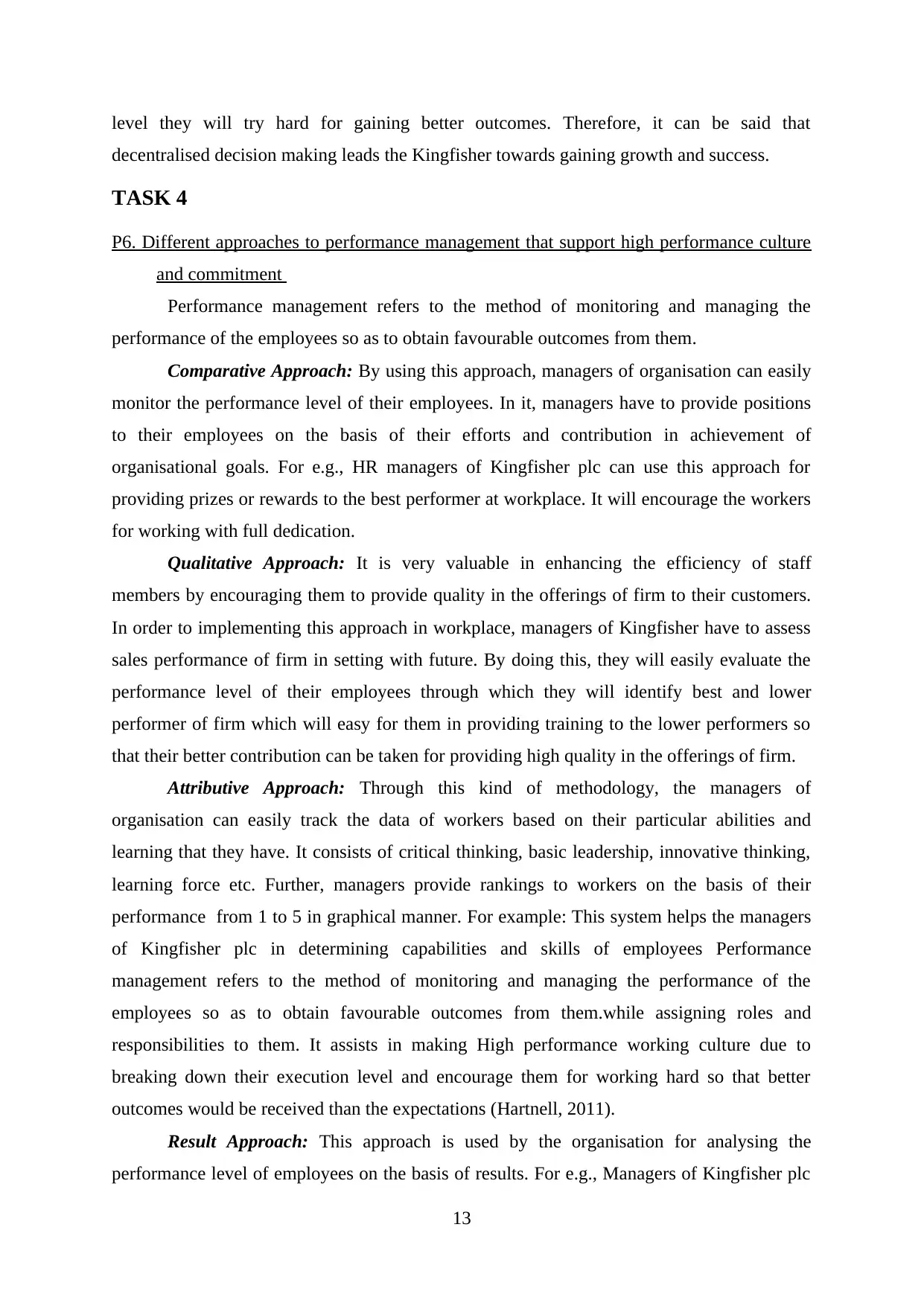
level they will try hard for gaining better outcomes. Therefore, it can be said that
decentralised decision making leads the Kingfisher towards gaining growth and success.
TASK 4
P6. Different approaches to performance management that support high performance culture
and commitment
Performance management refers to the method of monitoring and managing the
performance of the employees so as to obtain favourable outcomes from them.
Comparative Approach: By using this approach, managers of organisation can easily
monitor the performance level of their employees. In it, managers have to provide positions
to their employees on the basis of their efforts and contribution in achievement of
organisational goals. For e.g., HR managers of Kingfisher plc can use this approach for
providing prizes or rewards to the best performer at workplace. It will encourage the workers
for working with full dedication.
Qualitative Approach: It is very valuable in enhancing the efficiency of staff
members by encouraging them to provide quality in the offerings of firm to their customers.
In order to implementing this approach in workplace, managers of Kingfisher have to assess
sales performance of firm in setting with future. By doing this, they will easily evaluate the
performance level of their employees through which they will identify best and lower
performer of firm which will easy for them in providing training to the lower performers so
that their better contribution can be taken for providing high quality in the offerings of firm.
Attributive Approach: Through this kind of methodology, the managers of
organisation can easily track the data of workers based on their particular abilities and
learning that they have. It consists of critical thinking, basic leadership, innovative thinking,
learning force etc. Further, managers provide rankings to workers on the basis of their
performance from 1 to 5 in graphical manner. For example: This system helps the managers
of Kingfisher plc in determining capabilities and skills of employees Performance
management refers to the method of monitoring and managing the performance of the
employees so as to obtain favourable outcomes from them.while assigning roles and
responsibilities to them. It assists in making High performance working culture due to
breaking down their execution level and encourage them for working hard so that better
outcomes would be received than the expectations (Hartnell, 2011).
Result Approach: This approach is used by the organisation for analysing the
performance level of employees on the basis of results. For e.g., Managers of Kingfisher plc
13
decentralised decision making leads the Kingfisher towards gaining growth and success.
TASK 4
P6. Different approaches to performance management that support high performance culture
and commitment
Performance management refers to the method of monitoring and managing the
performance of the employees so as to obtain favourable outcomes from them.
Comparative Approach: By using this approach, managers of organisation can easily
monitor the performance level of their employees. In it, managers have to provide positions
to their employees on the basis of their efforts and contribution in achievement of
organisational goals. For e.g., HR managers of Kingfisher plc can use this approach for
providing prizes or rewards to the best performer at workplace. It will encourage the workers
for working with full dedication.
Qualitative Approach: It is very valuable in enhancing the efficiency of staff
members by encouraging them to provide quality in the offerings of firm to their customers.
In order to implementing this approach in workplace, managers of Kingfisher have to assess
sales performance of firm in setting with future. By doing this, they will easily evaluate the
performance level of their employees through which they will identify best and lower
performer of firm which will easy for them in providing training to the lower performers so
that their better contribution can be taken for providing high quality in the offerings of firm.
Attributive Approach: Through this kind of methodology, the managers of
organisation can easily track the data of workers based on their particular abilities and
learning that they have. It consists of critical thinking, basic leadership, innovative thinking,
learning force etc. Further, managers provide rankings to workers on the basis of their
performance from 1 to 5 in graphical manner. For example: This system helps the managers
of Kingfisher plc in determining capabilities and skills of employees Performance
management refers to the method of monitoring and managing the performance of the
employees so as to obtain favourable outcomes from them.while assigning roles and
responsibilities to them. It assists in making High performance working culture due to
breaking down their execution level and encourage them for working hard so that better
outcomes would be received than the expectations (Hartnell, 2011).
Result Approach: This approach is used by the organisation for analysing the
performance level of employees on the basis of results. For e.g., Managers of Kingfisher plc
13
Paraphrase This Document
Need a fresh take? Get an instant paraphrase of this document with our AI Paraphraser
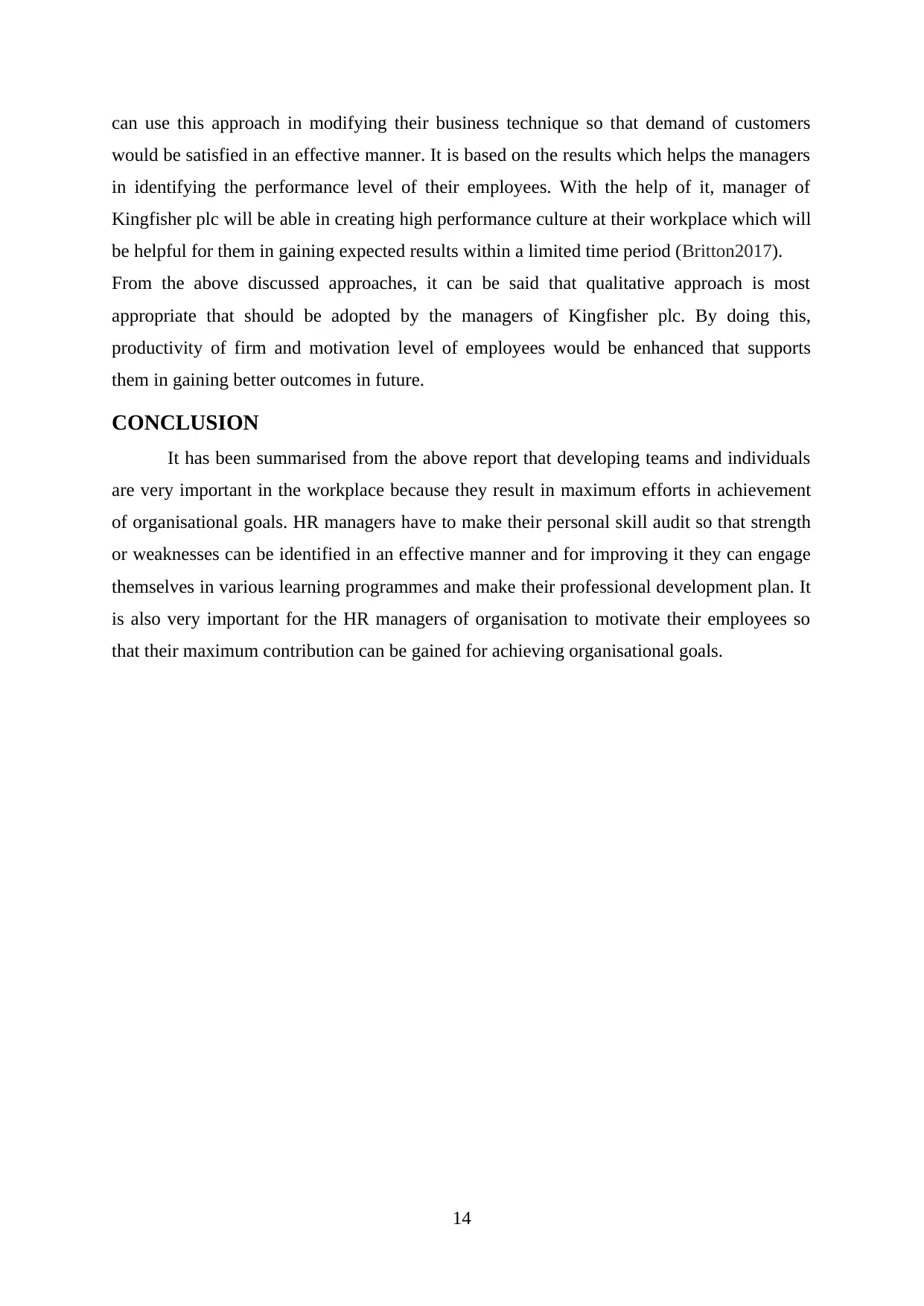
can use this approach in modifying their business technique so that demand of customers
would be satisfied in an effective manner. It is based on the results which helps the managers
in identifying the performance level of their employees. With the help of it, manager of
Kingfisher plc will be able in creating high performance culture at their workplace which will
be helpful for them in gaining expected results within a limited time period (Britton2017).
From the above discussed approaches, it can be said that qualitative approach is most
appropriate that should be adopted by the managers of Kingfisher plc. By doing this,
productivity of firm and motivation level of employees would be enhanced that supports
them in gaining better outcomes in future.
CONCLUSION
It has been summarised from the above report that developing teams and individuals
are very important in the workplace because they result in maximum efforts in achievement
of organisational goals. HR managers have to make their personal skill audit so that strength
or weaknesses can be identified in an effective manner and for improving it they can engage
themselves in various learning programmes and make their professional development plan. It
is also very important for the HR managers of organisation to motivate their employees so
that their maximum contribution can be gained for achieving organisational goals.
14
would be satisfied in an effective manner. It is based on the results which helps the managers
in identifying the performance level of their employees. With the help of it, manager of
Kingfisher plc will be able in creating high performance culture at their workplace which will
be helpful for them in gaining expected results within a limited time period (Britton2017).
From the above discussed approaches, it can be said that qualitative approach is most
appropriate that should be adopted by the managers of Kingfisher plc. By doing this,
productivity of firm and motivation level of employees would be enhanced that supports
them in gaining better outcomes in future.
CONCLUSION
It has been summarised from the above report that developing teams and individuals
are very important in the workplace because they result in maximum efforts in achievement
of organisational goals. HR managers have to make their personal skill audit so that strength
or weaknesses can be identified in an effective manner and for improving it they can engage
themselves in various learning programmes and make their professional development plan. It
is also very important for the HR managers of organisation to motivate their employees so
that their maximum contribution can be gained for achieving organisational goals.
14
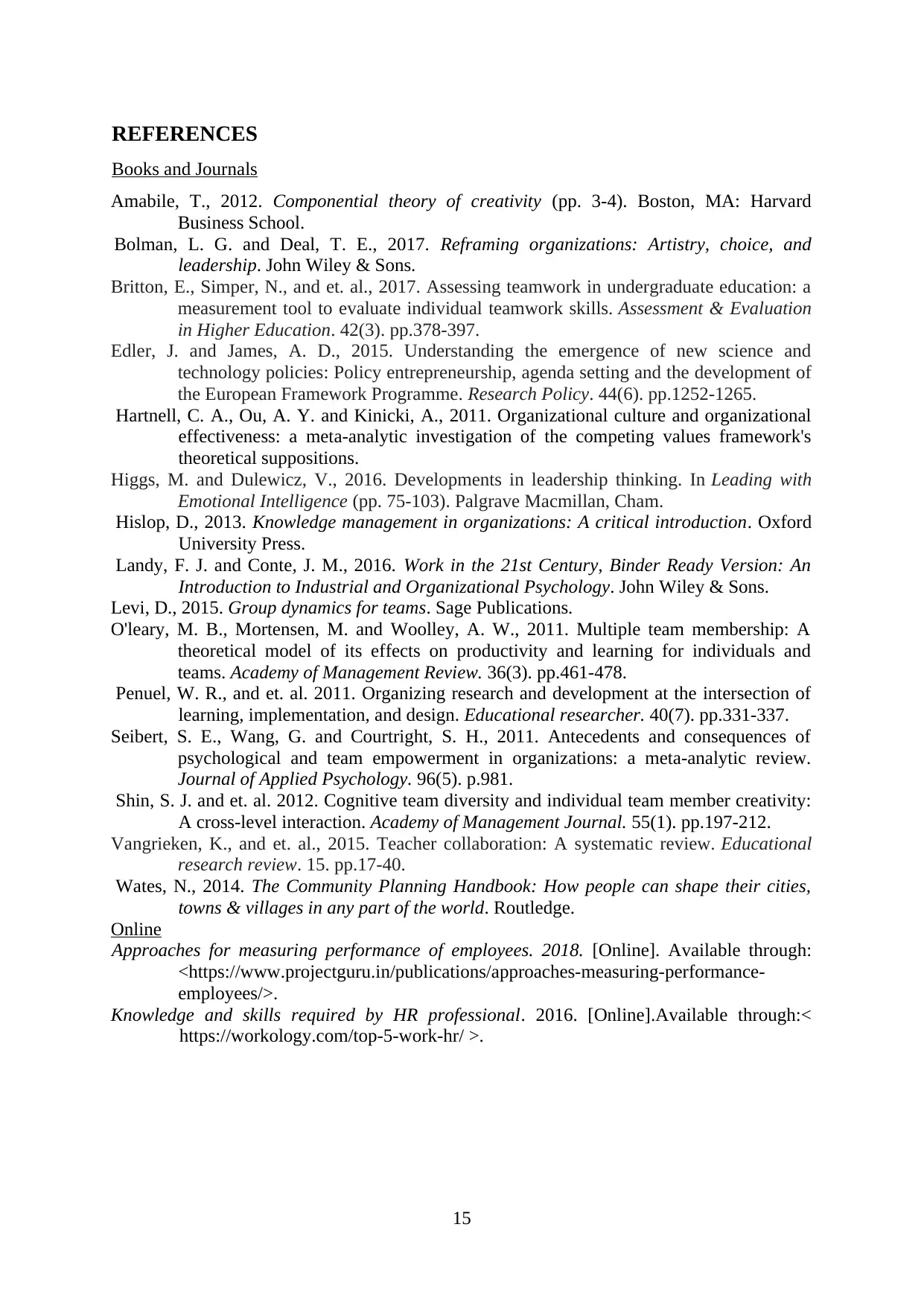
REFERENCES
Books and Journals
Amabile, T., 2012. Componential theory of creativity (pp. 3-4). Boston, MA: Harvard
Business School.
Bolman, L. G. and Deal, T. E., 2017. Reframing organizations: Artistry, choice, and
leadership. John Wiley & Sons.
Britton, E., Simper, N., and et. al., 2017. Assessing teamwork in undergraduate education: a
measurement tool to evaluate individual teamwork skills. Assessment & Evaluation
in Higher Education. 42(3). pp.378-397.
Edler, J. and James, A. D., 2015. Understanding the emergence of new science and
technology policies: Policy entrepreneurship, agenda setting and the development of
the European Framework Programme. Research Policy. 44(6). pp.1252-1265.
Hartnell, C. A., Ou, A. Y. and Kinicki, A., 2011. Organizational culture and organizational
effectiveness: a meta-analytic investigation of the competing values framework's
theoretical suppositions.
Higgs, M. and Dulewicz, V., 2016. Developments in leadership thinking. In Leading with
Emotional Intelligence (pp. 75-103). Palgrave Macmillan, Cham.
Hislop, D., 2013. Knowledge management in organizations: A critical introduction. Oxford
University Press.
Landy, F. J. and Conte, J. M., 2016. Work in the 21st Century, Binder Ready Version: An
Introduction to Industrial and Organizational Psychology. John Wiley & Sons.
Levi, D., 2015. Group dynamics for teams. Sage Publications.
O'leary, M. B., Mortensen, M. and Woolley, A. W., 2011. Multiple team membership: A
theoretical model of its effects on productivity and learning for individuals and
teams. Academy of Management Review. 36(3). pp.461-478.
Penuel, W. R., and et. al. 2011. Organizing research and development at the intersection of
learning, implementation, and design. Educational researcher. 40(7). pp.331-337.
Seibert, S. E., Wang, G. and Courtright, S. H., 2011. Antecedents and consequences of
psychological and team empowerment in organizations: a meta-analytic review.
Journal of Applied Psychology. 96(5). p.981.
Shin, S. J. and et. al. 2012. Cognitive team diversity and individual team member creativity:
A cross-level interaction. Academy of Management Journal. 55(1). pp.197-212.
Vangrieken, K., and et. al., 2015. Teacher collaboration: A systematic review. Educational
research review. 15. pp.17-40.
Wates, N., 2014. The Community Planning Handbook: How people can shape their cities,
towns & villages in any part of the world. Routledge.
Online
Approaches for measuring performance of employees. 2018. [Online]. Available through:
<https://www.projectguru.in/publications/approaches-measuring-performance-
employees/>.
Knowledge and skills required by HR professional. 2016. [Online].Available through:<
https://workology.com/top-5-work-hr/ >.
15
Books and Journals
Amabile, T., 2012. Componential theory of creativity (pp. 3-4). Boston, MA: Harvard
Business School.
Bolman, L. G. and Deal, T. E., 2017. Reframing organizations: Artistry, choice, and
leadership. John Wiley & Sons.
Britton, E., Simper, N., and et. al., 2017. Assessing teamwork in undergraduate education: a
measurement tool to evaluate individual teamwork skills. Assessment & Evaluation
in Higher Education. 42(3). pp.378-397.
Edler, J. and James, A. D., 2015. Understanding the emergence of new science and
technology policies: Policy entrepreneurship, agenda setting and the development of
the European Framework Programme. Research Policy. 44(6). pp.1252-1265.
Hartnell, C. A., Ou, A. Y. and Kinicki, A., 2011. Organizational culture and organizational
effectiveness: a meta-analytic investigation of the competing values framework's
theoretical suppositions.
Higgs, M. and Dulewicz, V., 2016. Developments in leadership thinking. In Leading with
Emotional Intelligence (pp. 75-103). Palgrave Macmillan, Cham.
Hislop, D., 2013. Knowledge management in organizations: A critical introduction. Oxford
University Press.
Landy, F. J. and Conte, J. M., 2016. Work in the 21st Century, Binder Ready Version: An
Introduction to Industrial and Organizational Psychology. John Wiley & Sons.
Levi, D., 2015. Group dynamics for teams. Sage Publications.
O'leary, M. B., Mortensen, M. and Woolley, A. W., 2011. Multiple team membership: A
theoretical model of its effects on productivity and learning for individuals and
teams. Academy of Management Review. 36(3). pp.461-478.
Penuel, W. R., and et. al. 2011. Organizing research and development at the intersection of
learning, implementation, and design. Educational researcher. 40(7). pp.331-337.
Seibert, S. E., Wang, G. and Courtright, S. H., 2011. Antecedents and consequences of
psychological and team empowerment in organizations: a meta-analytic review.
Journal of Applied Psychology. 96(5). p.981.
Shin, S. J. and et. al. 2012. Cognitive team diversity and individual team member creativity:
A cross-level interaction. Academy of Management Journal. 55(1). pp.197-212.
Vangrieken, K., and et. al., 2015. Teacher collaboration: A systematic review. Educational
research review. 15. pp.17-40.
Wates, N., 2014. The Community Planning Handbook: How people can shape their cities,
towns & villages in any part of the world. Routledge.
Online
Approaches for measuring performance of employees. 2018. [Online]. Available through:
<https://www.projectguru.in/publications/approaches-measuring-performance-
employees/>.
Knowledge and skills required by HR professional. 2016. [Online].Available through:<
https://workology.com/top-5-work-hr/ >.
15
1 out of 15
Related Documents
Your All-in-One AI-Powered Toolkit for Academic Success.
+13062052269
info@desklib.com
Available 24*7 on WhatsApp / Email
![[object Object]](/_next/static/media/star-bottom.7253800d.svg)
Unlock your academic potential
© 2024 | Zucol Services PVT LTD | All rights reserved.


![[SOLVED] HR Manager Roles and Performance Management](/_next/image/?url=https%3A%2F%2Fdesklib.com%2Fmedia%2Fimages%2Frn%2Ff0d6351ef5144f789f18d4b8ebfc609e.jpg&w=256&q=75)


